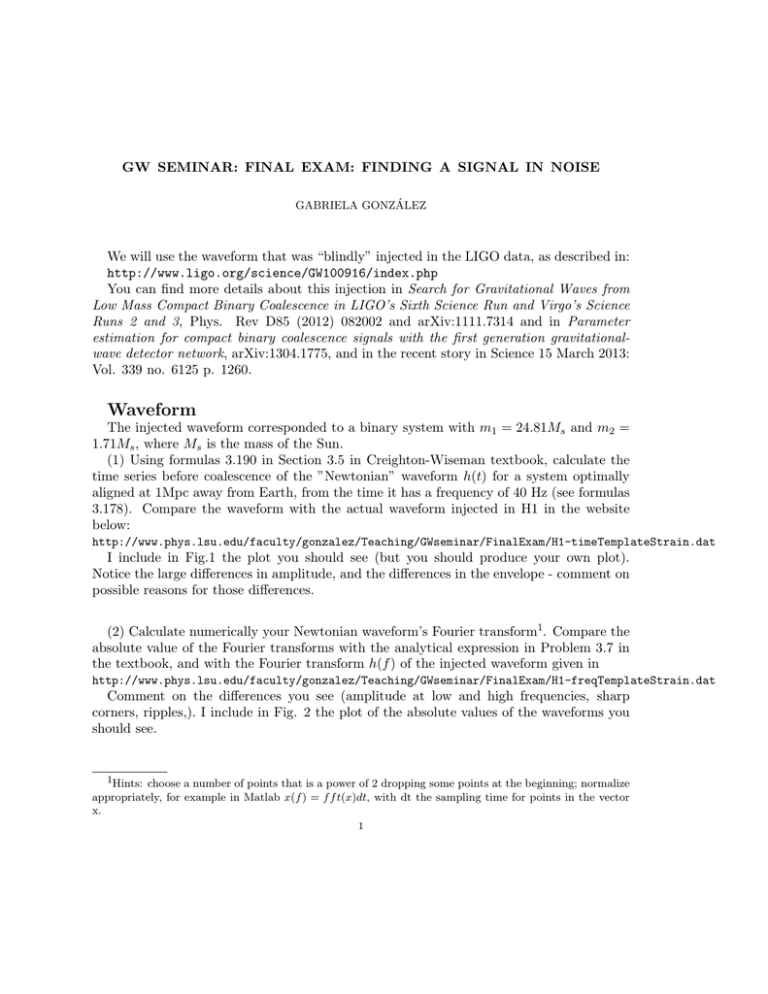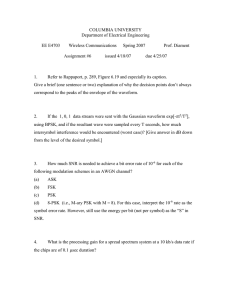Waveform
advertisement

GW SEMINAR: FINAL EXAM: FINDING A SIGNAL IN NOISE GABRIELA GONZÁLEZ We will use the waveform that was “blindly” injected in the LIGO data, as described in: http://www.ligo.org/science/GW100916/index.php You can find more details about this injection in Search for Gravitational Waves from Low Mass Compact Binary Coalescence in LIGO’s Sixth Science Run and Virgo’s Science Runs 2 and 3, Phys. Rev D85 (2012) 082002 and arXiv:1111.7314 and in Parameter estimation for compact binary coalescence signals with the first generation gravitationalwave detector network, arXiv:1304.1775, and in the recent story in Science 15 March 2013: Vol. 339 no. 6125 p. 1260. Waveform The injected waveform corresponded to a binary system with m1 = 24.81Ms and m2 = 1.71Ms , where Ms is the mass of the Sun. (1) Using formulas 3.190 in Section 3.5 in Creighton-Wiseman textbook, calculate the time series before coalescence of the ”Newtonian” waveform h(t) for a system optimally aligned at 1Mpc away from Earth, from the time it has a frequency of 40 Hz (see formulas 3.178). Compare the waveform with the actual waveform injected in H1 in the website below: http://www.phys.lsu.edu/faculty/gonzalez/Teaching/GWseminar/FinalExam/H1-timeTemplateStrain.dat I include in Fig.1 the plot you should see (but you should produce your own plot). Notice the large differences in amplitude, and the differences in the envelope - comment on possible reasons for those differences. (2) Calculate numerically your Newtonian waveform’s Fourier transform1. Compare the absolute value of the Fourier transforms with the analytical expression in Problem 3.7 in the textbook, and with the Fourier transform h(f ) of the injected waveform given in http://www.phys.lsu.edu/faculty/gonzalez/Teaching/GWseminar/FinalExam/H1-freqTemplateStrain.dat Comment on the differences you see (amplitude at low and high frequencies, sharp corners, ripples,). I include in Fig. 2 the plot of the absolute values of the waveforms you should see. 1Hints: choose a number of points that is a power of 2 dropping some points at the beginning; normalize appropriately, for example in Matlab x(f ) = f f t(x)dt, with dt the sampling time for points in the vector x. 1 2 GABRIELA GONZÁLEZ Figure 1. Waveforms of gravitational waves, using a ”newtonian chirp” formula (top), and the waveform injected in the H1 detector in 2010. Data Fourier transform and noise PSD For the next exercise, download the first 8 seconds of data s(t) for the H1 detector including the time of the injection from http://www.ligo.org/science/GW100916/H-strain hp30-968654552-10.txt Also, generate 8 seconds of simulated strain random data sr (t) with zero mean and mean square 10−21 . Fig. 3 shows the injected waveform strain time series compared with the actual LIGO H1 data and the simulated data. (3) Calculate the Fourier transform s(f ) of the H1 data (using 8 seconds) using a Hann window, and a noise power spectral density Sn (f ) also using a Hann window. Do the same for the simulated random data (the spectral density of white noise should be approximately GW SEMINAR: FINAL EXAM: FINDING A SIGNAL IN NOISE 3 Figure 2. Fourier transforms of gravitational waveforms. R constant). The PSD integral Sn (f )df should be approximately the same as the mean square of the (windowed) data. You may want to resample some of these quantities to have them all correspond to the same frequency vector. p Figure 4 shows the amplitude spectral density Sn (f ) of √ the windowed real data, as well as the amplitude of the data Fourier transform |s(f )| f (with similar units to the ASD), and the waveform Fourier transform scaled in the same way. Large Signal to noise ratio time series (4) If you use the injected waveform Fourier transform h(f ), you should expect a peak in SNR at the beginning of the template (see Fig1). To shift the peak to the largest amplitude point, use the template multiplied by e2iπf ∆t , where ∆t is the length of the waveform time series used. Using the shifted waveform Fourier transform h(f ) and the noise PSD Sn (f ) to calculate a template normalization: Z ∞ |h(f )|2 df σ2 = 4 Sn (f ) 0 4 GABRIELA GONZÁLEZ Figure 3. Injected waveform time series compared with actual H1 data and simulated data. Notice the different vertical scales, and that the injected waveform in the top panel is multiplied by 10,000. Compare the result with what you would get in white noise with rms 10−21 . (5) Calculate the signal to noise ratio time series ρ = |z(t)|/σ, where Z ∞ s(f )h∗ (f ) i2πf t z(t) = 4 e df Sn (f ) 0 Fig 5. shows the SNR time series I obtained with the procedure above. Find the time of the maximum SNR (within a fraction of a second) - how does that compare with the GPS time quoted in the website below? What do you think the envelope of the time series is due to? For comparison, I show in Fig 6 the SNR time series using the same procedure on random white data with 10−21 rms (without windowing). Do you think the differences in SNR peak and time series are consistent with expectations? http://www.ligo.org/science/GW100916/index.php GW SEMINAR: FINAL EXAM: FINDING A SIGNAL IN NOISE Figure 4. H1 amplitude spectral density, and Fourier transform of H1 data and injected waveform. Notice that the ASD of white noise with 10−21 rms strain sampled at 1 kHz is constant, about 3 × 10−21 . 5 6 GABRIELA GONZÁLEZ Figure 5. SNR time series for the injected waveform in H1 (windowed) data. GW SEMINAR: FINAL EXAM: FINDING A SIGNAL IN NOISE Figure 6. SNT time series of the waveform injected in H1 in random data with rms 10−21 . 7




